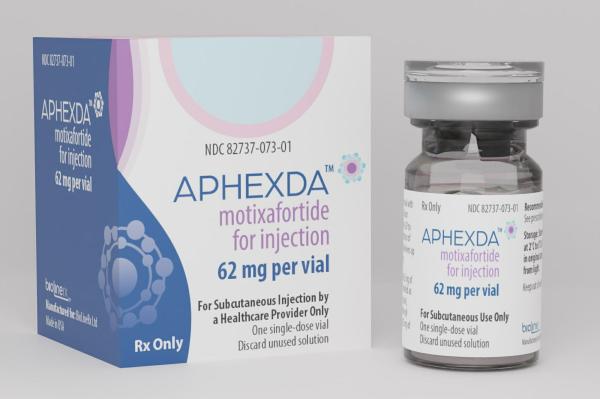Motixafortide Dosage
Medically reviewed by Drugs.com. Last updated on Jan 16, 2024.
Applies to the following strengths: 62 mg
Usual Adult Dose for:
Additional dosage information:
Usual Adult Dose for Multiple Myeloma
1.25 mg/kg via slow (approximately 2 minutes) subcutaneous injection 10 to 14 hours prior to the initiation of the first apheresis
Comments:
- Premedicate all patients before each dose of this drug to reduce the risk of hypersensitivity and injection site reactions. Administer approximately 30 to 60 minutes before injection of this drug:
- Diphenhydramine (12.5 mg IV or 25 mg to 50 mg orally, or another H1-antihistamine)
- H2 blocker (e.g., famotidine)
- Leukotriene inhibitor (e.g., montelukast)
- The addition of an analgesic medication (e.g., acetaminophen) to the premedication regimen is recommended.
- A second dose of this drug can be administered 10 to 14 hours before a third apheresis, if necessary
- Inject filgrastim at a dose of 10 mcg/kg of the patient's actual body weight subcutaneously once a day for 4 days leading up to the initial dose of this medication, and then on each day prior to every apheresis session.
- Dosing is based on actual body weight.
- If required, a second dose of this medication can be administered 10 to 14 hours before a third apheresis procedure.
Use: To mobilize hematopoietic stem cells to the peripheral blood for collection and subsequent autologous transplantation in patients with multiple myeloma
Renal Dose Adjustments
Data not available
Liver Dose Adjustments
Data not available
Dose Adjustments
Data not available
Precautions
CONTRAINDICATIONS: History of serious hypersensitivity reactions to this drug
Safety and efficacy have not been established in patients younger than 18 years.
Consult WARNINGS section for additional precautions.
Dialysis
Data not available
Other Comments
Administration advice:
- Administer this drug in combination with filgrastim (G-CSF).
- Inject this drug into the abdomen, the back or side of the upper arms, or the thighs. Rotate injection sites.
- Never administer an injection into areas with scar tissue, or where the skin appears reddened, inflamed, or swollen.
- When injecting into the abdomen, avoid a circular area with a 5 cm diameter around the navel.
- If multiple injections are required for a single dose of the medication, make sure that the injection sites are at least 2 cm apart from previous injection sites.
- Dispose of any remaining unused portion of the medication.
- After administering the drug, closely monitor patients for one hour.
Storage requirements:
- Keep this drug product stored within the range of 2C to 8C (36F to 46F) in its original packaging to shield it from light exposure.
- Dispose of any prepared reconstituted solution if it has been stored for 24 hours either in the refrigerator 2C to 8C (36F to 46F) or at room temperature 20C to 25C (68F to 77F), making sure to protect it from light.
Reconstitution/preparation techniques:
- Refer to manufacturer product information.
Patient advice:
- Inform patients about the potential occurrence of anaphylactic and hypersensitivity reactions (including symptoms like itching, flushing, hives, rash, vomiting, nausea, and chills) both during and after receiving injection of this drug and to promptly report any such signs or symptoms to their healthcare providers.
- Patients should be aware that this drug may lead to injection site reactions, such as pain, redness, and swelling.
- For women of reproductive age, advise the use of effective contraception methods while undergoing this treatment and for 8 days following the administration of this drug.
- Educate women of reproductive age about the potential risks to a developing fetus and instruct them to contact their healthcare provider if they become pregnant or suspect pregnancy while receiving this treatment.
- Breastfeeding is not recommended during this treatment and for 8 days after the last dose.
More about motixafortide
- Check interactions
- Compare alternatives
- Side effects
- During pregnancy
- Drug class: hematopoietic stem cell mobilizer
- En español
Patient resources
Other brands
Professional resources
Other brands
Related treatment guides
See also:
Further information
Always consult your healthcare provider to ensure the information displayed on this page applies to your personal circumstances.


